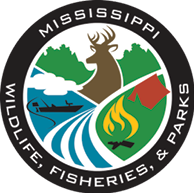Sport Fish Suppliers and Stocking Guidelines for Stocking Mississippi Ponds
As a pond owner, you face decisions in selecting a fish supplier. Here are some questions to ask before making an informed decision:
- Is there a warranty on the fish? Keep in mind that fish may be delivered alive but may die several days later because of hauling stress, insufficient tempering to the pond water, or disease. Get it in writing.
- Does the supplier produce the fish, or does he or she buy them from a third party? Vendors who produce their own fish are more likely to know the health history and pedigree of the fish.
- What species and sizes of fish do they supply? Not all suppliers sell all species of fish, and the sizes, strains, or reproductive capacity might not be right for your pond.
- Check references. Ask to contact some of their satisfied customers. Check out the company with the Better Business Bureau from their state.
Your MSU Extension agent, local Mississippi Department of Wildlife, Fisheries, and Parks biologist, or a specialist from the MSU Department of Wildlife, Fisheries, and Aquaculture can help you with stocking plans free of charge. Basic stocking recommendations for Mississippi farm ponds are given here for your convenience.
Recommended Fish Species for Mississippi Farm Ponds
The widely recommended combination for sustainable good fishing is largemouth bass, bream (either bluegill alone or a combination of bluegill and redear sunfish), and channel catfish.
In a properly managed pond, largemouth bass and bluegill have consistent reproduction and create a predator-prey balance that can sustain good fishing for years without restocking. Redear sunfish, also known as “shellcrackers,” also reproduce naturally and provide additional fishing opportunities and control of snails that may promote fish parasites.
Channel catfish usually do not reproduce well in ponds with largemouth bass and must be restocked periodically. The replacement catfish should be at least 8 inches long to avoid being eaten by the bass.
Either northern largemouth bass or Florida largemouth bass are appropriate for stocking in Mississippi farm ponds, but it is best not to mix the two.
It does not matter whether you stock regular bluegill or coppernose bluegill.
Under no circumstances should you stock hybrid bream with other species of bream, nor should you stock them when bass fishing is your main objective. Hybrid bream are best suited for very small ponds where they will be fed and harvested.
Triploid grass carp, or “triploid white amur,” should be stocked to help prevent invasion of aquatic weed species. We recommend only triploid grass carp in Mississippi; please request verified triploids.
In new ponds or ponds without weed problems, five grass carp per acre should be enough. If weeds are a problem, you may need 15 or more grass carp per acre. Grass carp eat vegetation, so do not introduce them into ponds where you want plant growth.
You can introduce fathead minnows and threadfin shad as extra bass food. It is best to stock these fragile species when water temperatures are cool in the fall or spring. Fathead minnows usually need to be restocked, since bass can quickly eliminate them. Threadfin shad are more persistent, but they may die out in very cold winters in northern Mississippi and will need to be restocked. Stock threadfin shad only when managing for trophy bass, since they may compete with bream.
We do not recommend crappie, other sunfish species (besides those listed above), or other catfish species in ponds. We do not recommend crappie for impoundments less than 50 acres because they tend to overpopulate, resulting in a pond full of stunted fish. They compete with both bass and bream for food and even prey on young sport fish. Verified triploid crappie and hybrid striped bass will not reproduce in ponds and can be used to add variety in fishing ponds, although they may compete with bass and bream for food.
Do not stock any other species of fish without first consulting your MSU Extension agent, local Mississippi Department of Wildlife, Fisheries, and Parks biologist, or a specialist from the Department of Wildlife, Fisheries, and Aquaculture at Mississippi State University.
In a new or renovated pond, stock bluegill and redear sunfish in the fall, along with channel catfish and grass carp, if desired. The pond does not need to be full when you stock, as long as the pond will fill to full pool by the following spring. Stock fish based on the full pond acreage, not on the surface acreage at the time of stocking. You do not need large fish, since predators are not in the pond at this time.
Stock largemouth bass fingerlings the following spring. This way, the bream have had time to produce young bream for the bass to eat. Stock fish only at the recommended rates and ratios listed here. You can begin fishing the pond after 1 year, but do not begin harvesting bream until the second year, and do not begin harvesting bass until the third year. If this stocking schedule cannot be followed, contact your local fisheries biologist or Extension specialist for customized stocking recommendations.
Do not catch and move fish from another water body to stock a pond. A number of serious pond problems can result from this stocking approach:
- First, some fish species look very similar and can be easily mistaken. Although spotted bass, longear sunfish, and young gizzard shad look very similar to largemouth bass, redear sunfish, and threadfin shad, they certainly don’t perform the same in farm ponds!
- Second, moving fish between water bodies is an easy way to introduce serious diseases and parasites to your pond.
- Third, it is very difficult to get the numbers of small fish needed to start the pond off “in balance.” Working with a certified fish supplier ensures that you stock the right numbers and sizes of disease-free fish.
Recommended Stocking Rates and Species Combinations
Table 1 lists stocking recommendations for ponds greater than 1 acre. Only hybrid bream, channel catfish-hybrid bream, and channel catfish-only combinations are recommended for ponds less than 1 acre. For both combinations containing bass and bluegill, no other bass or bream stocking is usually necessary after the initial stocking. Periodic restocking is required for hybrid bream and may be required for channel catfish.
When stocking channel catfish into an established bass population, stock 8- to 10-inch fish to avoid feeding catfish to your bass. If managing for trophy bass fishing, you may want additional prey. You can stock fathead minnows at 500 per acre, but these will likely be eliminated within a few months. Restock as necessary.
Threadfin shad are another prey option and should be stocked at 250 or more per acre. Be careful that you do not stock gizzard shad. Threadfin shad should reproduce in the pond and do not need to be restocked unless a cold winter causes a threadfin winter kill.
|
Stocking combination |
Largemouth bass |
Bluegill |
Redear sunfish |
Channel catfish |
Grass carp |
Hybrid bream |
|---|---|---|---|---|---|---|
|
Bass-bluegill |
50 |
500 |
50b |
5c |
||
|
Bass-bluegill-redear sunfish |
50 |
350 |
150 |
50b |
5c |
|
|
Hybrid bream |
50d |
750 |
||||
|
Channel catfish-hybrid bream |
100 |
350–500 |
||||
|
Channel catfish only |
100–150 |
aDouble rates if the pond will be fertilized.
bOptional. Stock up to 50 channel catfish per acre if desired.
cRecommended. Stocking five grass carp per acre in weed-free ponds helps prevent future weed problems.
dLargemouth bass are to control hybrid bream reproduction. Stock them at the same time as hybrid bream fingerlings, and do not harvest bass.
Transporting and Tempering Fish
Depending on the quantity of fish purchased, many fish suppliers will deliver and stock fish in your pond for a charge. Many pond owners do not purchase enough fish to warrant this expense, and it is more economical for them to transport and stock their own fish.
However, hauling fish is tricky business, and many fish have died due to improper hauling and stocking. Your goal is to release healthy fish that survive, grow, and reproduce in your pond, so follow these recommendations if you plan to haul your own fish.
Poor water quality, overcrowding, and improper tempering can result in large or complete losses of fish. Water quality management during hauling and stocking is critical. It is especially important that you make sure there is adequate dissolved oxygen and low levels of toxic waste products such as ammonia and carbon dioxide. Temperature, pH, fish density, and length of trip affect the severity of these problems. Never haul fish when it is 85°F or more outside, and carry less fish per water volume for longer trips.
When hauling fingerlings to your pond, ask the producer to “bag them.” Many producers supply hauling bags and pure oxygen, and will prepare each bag with clean water, the optimum number of fish, and pure oxygen to fill the bags. Lay the bags down horizontally in a shaded container such as a cooler or cardboard box. Laying them down maximizes the contact between the water surface and the oxygen, which diffuses into the water as needed. Do not leave the bags in direct sunlight as the water will quickly heat up, killing the fish.
Some producers may not supply bags and oxygen, and most will not bag channel catfish because their spines will easily puncture bags. In this case, you should plan to bring large water-tight containers to haul your fish (large coolers work well for small numbers of fish).
Provide some form of aeration for hauls longer than 30 minutes. Battery-powered aerators with air stones are an inexpensive means of providing oxygen, but these are not very efficient. Use as many aerators as possible, and carry low fish densities (fewer than 100 2-inch fingerlings per gallon).
Be careful when filling the tanks from a well, as well water is usually low in oxygen and high in carbon dioxide. Aerate thoroughly before adding fish. Do not use municipal water, as it may have chlorine or other chemicals that are toxic to fish.
When you arrive at the pond, it is very important to temper, or adjust, the fish to the new environment. The sudden shock of changing water temperature can stress or kill fish. If your fish are in bags, simply float the bags in the pond for at least 30 minutes, and then check to make sure that the temperatures are similar before releasing them. Float the bags out of direct sunlight if possible.
If your fish were hauled in containers, slowly add pond water to the containers using a bucket or pump. Change about 25 percent of the water volume every 5 to 10 minutes until the temperatures in the tank and receiving waters are similar. It should then be safe to release the fish into the pond.
See Table 2 for a list of sport fish suppliers.
|
HATCHERY |
EMAIL OR WEBSITE |
CITY/STATE |
PHONE |
FISH SPECIES |
|||||||||||
|---|---|---|---|---|---|---|---|---|---|---|---|---|---|---|---|
|
NL |
FL |
HL |
BG |
CN |
RE |
HB |
CC |
FM |
GC |
TS |
HS |
||||
|
American Sport Fish Hatchery |
www.americansportfish.com |
Montgomery, AL |
334-281-7703 |
X |
X |
X |
X |
X |
X |
X |
X |
X |
|||
|
Circle C Fish Farm |
Dalecucullu@gmail.com |
Carriere, MS |
601-795-2329 |
X |
X |
X |
X |
X |
X |
||||||
|
Dunn’s Fish Farms Inc. |
www.dunnsfishfarm.com |
Fittstown, OK |
800-433-2950 |
X |
X |
X |
X |
X |
X |
X |
X |
X |
X |
||
|
Fish Wagon FWI, LLC, DBA |
www.fishwagon.com info@fishwagon.com |
Harrisburg, AR |
800-643-8439 |
X |
X |
X |
X |
X |
X |
X |
X |
||||
|
Hardin’s Fish |
www.hardinsfish.com jimmyhardin@TDS.net |
Calhoun City, MS |
662-983-8451 |
X |
X |
X |
X |
X |
X |
X |
X |
X |
X |
X |
|
|
Harvey G. Huffstatler d.b.a. MS Big Fish |
msbigfish.hh@gmail.com |
Jackson, MS |
601-613-5413 |
X |
X |
X |
X |
X |
X |
X |
X |
X |
X |
X |
X |
|
Hopper-Stephens Hatcheries Inc. |
hopperstephens@icloud.com |
Lonoke, AR |
501-676-2435 |
X |
X |
X |
X |
X |
X |
X |
|||||
|
Keo Fish Farm |
kkeo@centurytel.net |
Keo, AR |
501-842-2872 |
X |
X |
X |
|||||||||
|
J. M. Malone and Son |
www.jmmaloneandson.com information@jmmaloneandson.com |
Lonoke, AR |
501-676-2800 |
X |
X |
X |
X |
X |
X |
X |
X |
X |
X |
||
|
Natural Resource Management |
nrmc@comcast.net |
Collinsville, MS |
601-626-8088 |
X |
X |
X |
X |
X |
X |
X |
X |
||||
|
Parker’s Fish Farm |
www.parkersfishfarm.com |
Simpson, LA |
337-383-7820 |
X |
X |
X |
X |
X |
X |
X |
|||||
|
Scott Hill Farms |
Scottyhill6@yahoo.com |
Maben, MS |
662-418-6203 |
X |
X |
X |
X |
X |
X |
X |
X |
X |
X |
||
|
Slade’s Fish Hatchery |
sladesfish@yahoo.com |
Lumberton, MS |
601-796-2000 |
X |
X |
X |
X |
X |
X |
X |
X |
X |
X |
X |
X |
|
Southeastern Pond Management |
www.sepond.com |
Ridgeland, MS |
601-859-9920 |
X |
X |
X |
X |
X |
X |
X |
X |
X |
X |
X |
X |
|
Sunrise Fisheries |
www.sunrisefisheries.com |
Lake Village, AR |
870-265-1205 |
X |
X |
X |
X |
X |
X |
X |
X |
X |
|||
|
Suttle Fish Farm |
www.suttlefish.com |
Laurel, MS |
601-425-4480 |
X |
X |
X |
X |
X |
X |
X |
X |
X |
X |
X |
|
|
Ronnie Thomas |
DRT_Thom@BellSouth.Net |
Hattiesburg, MS |
601-466-5113 |
X |
X |
X |
X |
X |
X |
X |
X |
X |
X |
X |
X |
|
Warmwater Pond Management Inc. |
charliehogue@yahoo.com |
Madison, MS |
662-418-1382 |
X |
X |
X |
X |
X |
X |
X |
X |
X |
X |
X |
|
|
Wigington Stock Fish |
Ty-Wig@yahoo.com |
Blue Springs, MS |
662-401-5532 |
X |
X |
X |
X |
X |
X |
X |
X |
X |
X |
X |
|
NL = Northern largemouth bass
FL = Florida largemouth bass
HL = Hybrid largemouth bass
BG = Bluegill
CN = Coppernose bluegill
RE = Redear sunfish
HB = Hybrid bream
CC = Channel catfish
FM = Fathead minnows
GC = Grass carp (white amur)
TS = Threadfin shad
HS = Hybrid striped bass
This publication is a joint effort of the Mississippi State University Extension Service and the Mississippi Department of Wildlife, Fisheries, and Parks. To request corrections to the information provided or to have a farm included in the next printing of the list, send the correct information to wes.neal@msstate.edu.
Please note that Mississippi state law prohibits any person from selling or offering for sale or exchange any game fish whether taken within or coming from outside the state. Such sales are legal if MDAC has issued a permit to the owner of a private pond to sell fish grown or cultivated for stocking under the MDAC regulations.
All firms listed in this publication have a current MDAC permit.

The information given here is for educational purposes only. References to commercial products, trade names, or suppliers are made with the understanding that no endorsement is implied and that no discrimination against other products or suppliers is intended.
Publication 2525 (POD-12-23)
Distributed by Wes Neal, PhD, Extension/Research Professor, Wildlife, Fisheries, and Aquaculture.
The Mississippi State University Extension Service is working to ensure all web content is accessible to all users. If you need assistance accessing any of our content, please email the webteam or call 662-325-2262.





